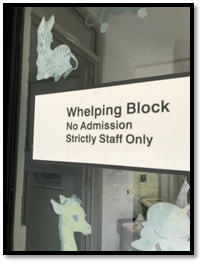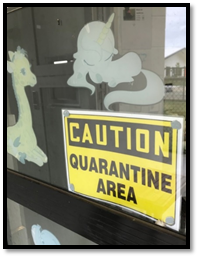Early Socialization Project - Concepts
Biosecurity
![]()
This is a guideline and is not intended to be a comprehensive document covering all aspects of biosecurity and infection control. Please consult the relevant Veterinary Specialist, Biosecurity Agencies, or relevant Government Departments.
Biosecurity is the basic of disease control and refers to all the policies and procedures undertaken by an organisation to minimise the risk of entry, emergence and spread of transmissible infectious diseases throughout a facility.
Keeping your breeding centre/kennels clear and free of pathogens will greatly reduce the chances of the common diseases from entering, spreading within, or leaving your facility. This is particularly important in the breeding centre as neonates do not yet have a fully developed immunity system and are more at risk of developing transmissible diseases. By limiting the entry and having a biosecurity plan in place will help to keep the colony healthy and disease free.


The cost of treating any disease outbreak is expensive but the true cost will be higher. Tragically, by not following biosecurity protocols the risk is there of losing multiple litters or indeed the whole colony. A significant percentage of infections can likely be prevented with proper compliance to basic, practical infection control practices. Understanding the application of excellent infection control principles are important requirements of any facility working with puppies or dogs.
In addition, it will
- help protect staff and volunteers from exposure to zoonotic disease agents
- minimise the risk of infection to puppies
It is essential that all staff and volunteers learn and apply best practice in biosecurity and infection control in the breeding/kennel environment.
It is everyone’s responsibility to
- educate, by example, all aspects of biosecurity and infection control
- to provide a clean, safe, and attractive working environment for everyone concerned
- protect the operational capabilities of the organisation.
Some facilities will house and socialise pups within one building and puppies are only out in the real world when they are placed with the raisers. Other facilities have a different set up and allow pups outside the breeding centre/kennel area engaging in on-site outings and off-site outings (once vaccinated). Whichever method is employed, ensure you are guided by a Veterinary Specialist who will weigh up the risk associated versus the benefit of any socialization system employed.
The 3 tiers of biosecurity
The 3 tiers of biosecurity are conceptual, structural, and procedural. The procedural tier is most relevant to staff and volunteers. The structural and conceptual tiers will not be be addressed here but still research them as they provide a good insight into all areas of bio security.
The procedural tier is important for both staff and volunteers to fully understand and implement each time they enter or leave the facility.
The procedural tier involves the routine procedures to prevent introduction (bio- exclusion) and spread (bio containment) of infection within a facility. The procedures used need to be reviewed on a regular basic especially if any breach occurred or a puppy/dog/human becomes infected. One practical method of achieving this is through separation of litters onto cohorts (color coding litters) to reduce cross contamination between litters within the same facility.
Post signs around your breeding and kennel area and at any entry point (even if the door is kept locked most of the time) indicating this is an area of quarantine and the procedures in place to keep your puppies healthy.
Example: Outside Breeding Centre
Examples: Inside Breeding Centre
- Upon entering the breeding or kennel area either leave outdoor shoes outside building or cover outside shoes with disposable plastic overshoe booties.
- Proceed to hand washing station: Wash hands either with foam or gel and wash off with water. Alternatively, use a sanitising hand wash.
Hand Washing
Hands are one of the principal ways that disease causing organisms are transmitted. Hand washing is probably the most important procedure for reducing the number of pathogens. Antimicrobial containing products will kill or inhibit the growth of microorganisms.
Hand hygiene is the responsibility of all individuals working with animals. Effective hand hygiene kills or removes microorganisms on the skin while maintaining hand health and skin integrity (i.e. prevents chapping and cracking of skin). Sterilization of the hands is not the goal of routine hand hygiene – the objective is to reduce the number of microorganisms on the hands, particularly the number of microorganisms that are part of the transient microflora of the skin, as these include the majority of opportunistic pathogens on the hands. These transient microbes may be picked up by contact with a patient, another person, contaminated equipment, or the environment.
There are two methods of removing/killing microorganisms on hands: washing with soap and running water or using an alcohol-based hand sanitizer. Hand hygiene is the single most important way to prevent infections in the breeding/kennel setting.
- HAND WASHING
Most transient bacteria present on the hands are removed during the mechanical action of washing, rinsing and drying hands. Hand washing with soap and running water must be performed when entering, during and upon leaving the working environment.
If running water is not available, use moistened towelettes to remove all visible dirt and debris, followed by an alcohol-based hand rub. Either liquid or foam soap should be used and dispensed in a pump dispenser.
Soap containers should not be refilled without being disinfected, since there is a risk of contaminated antibacterial soaps, where invasive procedures are performed. Antibacterial soaps should be used before entering a high-risk area, such as the den when the brood is whelping.
- ALCOHOL HAND SANITISER
There are also alcohol hand sanitiser bottles that need to be positioned around the building for all personnel to use intermittently throughout the day. Bar soaps are not acceptable because of the potential for transmission of pathogens from one person to another.
Wash hands before and after leaving a den or after contact with any body fluids, potentially infectious or contaminated material; before and after contact with items in den environment; before performing invasive procedures; before eating food and after personal body functions, such as using the toilet or blowing one’s nose
Recommended Technique for Hand Washing
- Remove all hand and arm jewellery.
- Wet hands with warm (not hot) water. Hot water is hard on the skin and will lead to dryness and additional skin damage.
- Apply liquid or foam soap.
- Vigorously lather all surfaces of hands for a minimum of 20 seconds. This is the minimum amount of time required for mechanical removal of transient bacteria.
- Pay attention to fingertips, between fingers, backs of the hands and base of the thumbs and under the nails. These are the most missed areas. A simple way many people time their hand washing is by singing “Happy Birthday”.
- Using a rubbing motion, thoroughly rinse soap from hands under warm running water. Residual soap can lead to dryness and cracking of skin.
- Dry hands thoroughly by blotting hands gently with a paper towel. Rubbing vigorously with paper towels can damage the skin.
- Turn off taps with paper towel to avoid recontamination of your hands.
NOTE: If air hand dryers are used, hands-free taps are necessary, as turning taps off without using paper towel as described will result in recontamination of hands after washing. It is recommended that jewellery not be worn on the hands during working hours as it is difficult to wash hands adequately, (rings can be kept on a neck chain in these circumstances). Short-sleeved clothing or sleeves to the elbow at maximum is recommended to facilitate adequate handwashing.

Position similar type posters at hand washing stations
Cleaning Protocols – Prevention & Control
Protocols must be in place for all hygiene measures that minimise the risk of animal to animal transmission of disease.
Disinfecting floors and surfaces as well as any equipment/materials used daily will help to reduce the load of pathogens plus reduce the risk of disease.
Date | Completed by: | BASIC EVERYDAY CLEANING OF PENS PROTOCOL |
/ / | __________ | Dogs in season: Scrub with GP4 |
/ / | __________ | Gerni or hose out |
/ / | __________ | Mop with S3 (use allocated buckets for each pen) |
/ / | __________ | Towel dry |
- Cleaning involves the removal of visible debris from surfaces with soap or detergent.
- Disinfection involves the application of a chemical to kill microbes that cannot be removed by cleaning.
- Ensure all areas are well ventilated during cleaning & disinfecting and disposable gloves are worn.
- First clean the surface by removing dried-on or sticky debris from surfaces using a cloth/paper towel and a kennel disinfectant (use correct dilution rates).
- Follow above by cleaning using a higher-grade disinfectant (e.g. Virkon S).
- Floor surfaces should be mopped using either a kennel disinfectant or a higher-grade disinfectant (Virkon S).
- Replace mop heads regularly and clean and disinfect mops are each use.
- Always apply cleaners and disinfectants according to the product label, paying attention to dilution rates and required contact time.
Reminder: Cleaning and disinfectant chemicals and materials must be chosen based on their suitability, safety and effectiveness and must be used in accordance with the manufacturer’s instructions.
Reference and helpful resource material
- www.vin.com
- https://www.hha.org.au/audits/audit-tools/other-audits
- http://www.oasishhi.com/oasis-blog/its-national-hand-washing-awareness-week
- Australian Veterinary Association Policy for Infection Control’ and ‘Code of Practice for Management of Hygiene and Infection Control’
- ‘Infection Prevention and Control Best Practices for Small Animal Veterinary Clinics’ developed by the Canadian Committee on Antibiotic Resistance (2008)
- Government Departments relevant to Biosecurity Protocols
